

Want to learn statistics? These are the best books, and they're free to download. Statistics came well before computers.
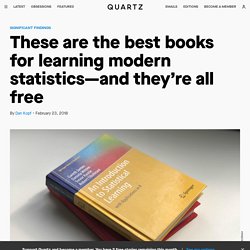
It would be very different if it were the other way around. The stats most people learn in high school or college come from the time when computations were done with pen and paper. Why am I so bad at math? You're not, you're just looking at it wrong. — Quartz. What does mathematics look like to you?

Do you see a wondrous landscape filled with connected ideas, or a sprawling mess of symbols? The distinction matters a great deal, because your mathematical worldview is inextricably tied to your success in the subject. We are all familiar with the multiplication grid, a centerpiece of classrooms and home studies the world over: You cannot fault this image for accuracy. Seeing Theory. JUMP Math, a teaching method that's proving there's no such thing as a bad math student — Quartz. Math is a notoriously hard subject for many kids and adults.

There is a gender gap, a race gap, and just generally bad performance in many countries. John Mighton, a Canadian playwright, author, and math tutor who struggled with math himself, has designed a teaching program that has some of the worst-performing math students performing well and actually enjoying math. There’s mounting evidence that the method works for all kids of all abilities. Essence of linear algebra preview. Essence of linear algebra. Puzzle Playground - Martin Gardner. OpenIntro. Hyperuniformity Found In Birds, Math And Physics. Welcome. 3Blue1Brown. Octave Online: Free Interface compatible with MATLAB. Aristotle was right about mathematics after all — Ae... What is mathematics about?
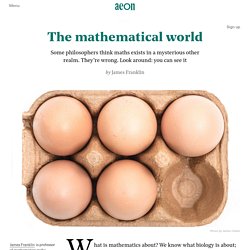
We know what biology is about; it’s about living things. Or more exactly, the living aspects of living things – the motion of a cat thrown out of a window is a matter for physics, but its physiology is a topic for biology. Oceanography is about oceans; sociology is about human behaviour in the mass long-term; and so on. When all the sciences and their subject matters are laid out, is there any aspect of reality left over for mathematics to be about? That is the basic question in the philosophy of mathematics. 21 GIFs That Explain Mathematical Concepts.
“Let's face it; by and large math is not easy, but that's what makes it so rewarding when you conquer a problem, and reach new heights of understanding.”
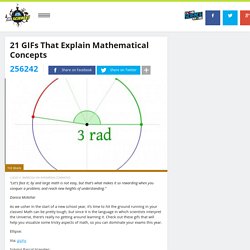
Wolfram Web Resources. Dynamically Created Math Worksheets. Math2.org. Visual Math Learning: A Free Online Tutorial for Teaching Math. Visual Calculus. 21 GIFs That Explain Mathematical Concepts. How do japanese multiply?? Mathemagic. Gödel's Incompleteness Theorem. What is Mathematics: Gödel's Theorem and Around. Incompleteness. By K. Podnieks. 8 math talks to blow your mind. Numberphile. Closer To Truth asks Roger Penrose: What Things Really Exist? 17 Equations That Changed The World. Euclid's Elements, Introduction. Euclid's Elements form one of the most beautiful and influential works of science in the history of humankind.
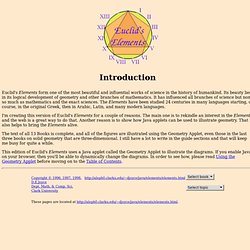
Its beauty lies in its logical development of geometry and other branches of mathematics. It has influenced all branches of science but none so much as mathematics and the exact sciences. The Elements have been studied 24 centuries in many languages starting, of course, in the original Greek, then in Arabic, Latin, and many modern languages. I'm creating this version of Euclid's Elements for a couple of reasons. ANCIENT GREEK GEOMETRY. The Geometry Junkyard. The Berlin Numeracy Test > Try It. Zipf, Power-law, Pareto - a ranking tutorial. Lada A.
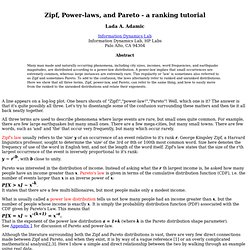
Adamic Information Dynamics Lab Information Dynamics Lab, HP Labs Palo Alto, CA 94304. Statistics, Probability, and Survey Sampling. Statlect, the digital textbook. WHAT ARE THE ODDS? The Ins and Outs of Probability. Game Theory 101: Game Theory Made Easy. Game Theory Explains How Cooperation Evolved. When the manuscript crossed his desk, Joshua Plotkin, a theoretical biologist at the University of Pennsylvania, was immediately intrigued.
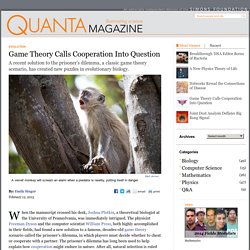
The physicist Freeman Dyson and the computer scientist William Press, both highly accomplished in their fields, had found a new solution to a famous, decades-old game theory scenario called the prisoner’s dilemma, in which players must decide whether to cheat or cooperate with a partner. The prisoner’s dilemma has long been used to help explain how cooperation might endure in nature. After all, natural selection is ruled by the survival of the fittest, so one might expect that selfish strategies benefiting the individual would be most likely to persist.
But careful study of the prisoner’s dilemma revealed that organisms could act entirely in their own self-interest and still create a cooperative community. Discrete Mathematics for Dummies. Finite Mathematics and Applied Calculus. Fractal Geometry. Doodling in Math: Spirals, Fibonacci, and Being a Plant [1 of 3] Beauty of mathematics. Another Look at Prime Numbers. Primes are numeric celebrities: they're used in movies, security codes, puzzles, and are even the subject of forlorn looks from university professors.
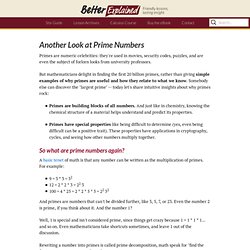
But mathematicians delight in finding the first 20 billion primes, rather than giving simple examples of why primes are useful and how they relate to what we know. Somebody else can discover the "largest prime" -- today let's share intuitive insights about why primes rock: Primes are building blocks of all numbers. And just like in chemistry, knowing the chemical structure of a material helps understand and predict its properties.Primes have special properties like being difficult to determine (yes, even being difficult can be a positive trait).
These properties have applications in cryptography, cycles, and seeing how other numbers multiply together. So what are prime numbers again? The Prime Pages (prime number research, records and resources) The On-Line Encyclopedia of Integer Sequences® (OEIS®) Infinity is bigger than you think - Numberphile.
Hilbert's Infinite Hotel - 60-Second Adventures in Thought (4/6) Imagining the Tenth Dimension - 2012 Version. Imagining the "Zeroth" Dimension. RAMANUJAN: Letters from an Indian Clerk. Leaner Fourier Transforms. By Helen Knight, MIT New algorithm can separate signals into their individual frequencies using a minimal number of samples.
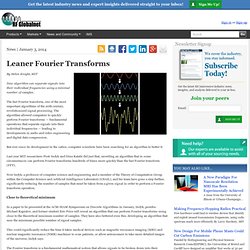
The fast Fourier transform, one of the most important algorithms of the 20th century, revolutionized signal processing. The algorithm allowed computers to quickly perform Fourier transforms — fundamental operations that separate signals into their individual frequencies — leading to developments in audio and video engineering and digital data compression. But ever since its development in the 1960s, computer scientists have been searching for an algorithm to better it. Last year MIT researchers Piotr Indyk and Dina Katabi did just that, unveiling an algorithm that in some circumstances can perform Fourier transforms hundreds of times more quickly than the fast Fourier transform (FFT). Close to theoretical minimum The Fourier transform is a fundamental mathematical notion that allows signals to be broken down into their component parts. Original Release: Braess’ Paradox – or Why improving something can make it worse. On Earth Day in 1990 they closed New York’s 42nd Street for the parade[1] and in 1999 one of the three main traffic tunnels in South Korea’s capital city was shut down for maintenance[2].
Bizarrely, despite both routes being heavily used for traffic, the result was not the predicted chaos and jams, instead the traffic flows improved in both cases. Inspired by their experience, Seoul’s city planners subsequently demolished a motorway leading into the heart of the city and experienced exactly the same strange result, with the added benefit of creating a 5-mile long, 1,000 acre park for the local inhabitants[3].